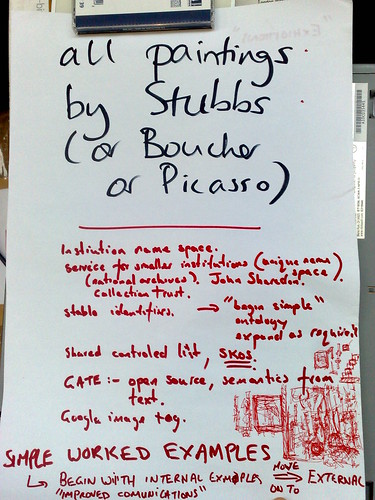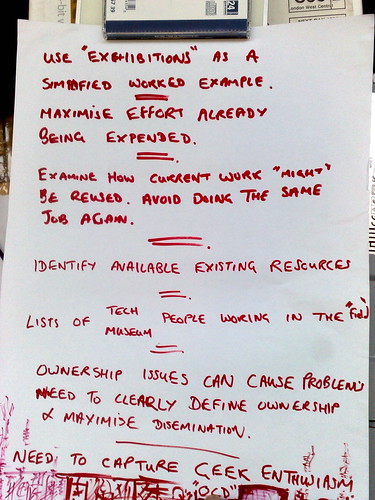A place to record some of the discussion from the 'Linking Museums' meetup on July 7, 2010. Please feel free to edit and add your notes, or comment on the page if that's easier for you.
I'd been desperately hoping I'd get away with not having to do any organising at the event, but I guess that was a bit unrealistic. In part because we needed to break up the tables to allow passage through the area, it seemed easiest to suggest 'birds of a feather'-style breakout discussions. Possible topics were called out, written on A3 paper then grouped (where appropriate) and passed over to different parts of the room.
It would have been a good idea to nominate a time to have each group report back on their discussions, but I didn't think of it at the time. This would also have given people a chance to easily move around between groups and start a different take on the same questions.
All paintings by Stubbs (or Boucher or Picasso)
Joe, Ian, Guys, Mia, Libby...
Posting Joe's notes, the lazy version (aka 'I've run out of lunchbreak to write them up in'):


Mia (notes from my phone, pretty much unedited): we need 'recipe books' for how to do the basic things.
Discussion of the activation energy to get started with various models.
What's the simplest possible start (that still allows for expansion into more detail later)? We need something simple so we don't lose 90% of museum geeks at the start. Too much structure and startup overhead is scary for busy museum staff with a million other bits of work going on.
What's the simplest thing needed for linked museums to work? Namespaces and stable identifiers? Neat problem to be solved: museum identifiers change as object status changes or they change institutions.
A discussion of the situation with smaller museums that are vulnerable to change (and therefore unable to provide the permanent part of permanent URIs, even if they were able to provide the rest of it) lead Ian to suggest PURIs provided by The National Archives. [This could be a brilliant idea - how to take it forward?]
How much of a standard is enough? Not being a perfect standard is ok but it can't lock you in and prevent future improvements. Joe : we need a skeleton but people need to understand that it's not buildable all at once.
Common use cases - starting an exhibition planning process. Republishing in all sorts of ways
Business cases (Libby)
We need a forum for hearing about good things already going on, for support and reality checks from peers...
Why linked data (and various other meta discussions) including how much structure, how is it going to be used (for formats, types of data).
Loads of people!
Paul:
1. Get the raw data out there.
Interesting to hear from Jonty & Richard (museum hackers) - any data is better than no data. Museums, get your raw data out. Stop worrying about completing it and perfecting it. It will never be perfect and waiting until you think it is will stop other trying to do interesting things with it.
Jonty & Richard both said a full dump was more use to them than individual pages, as they'd only have to write routines to find/scrape every page otherwise. The full dump might not be as up to date as the dynamic pages. Museums could provide full dump plus feed of recent changes.
2. Implement basic web best practice.
Each thing should have a persistent structured web page. e.g. Each object, event, place, person documented. Structured could be plain HTML, which is again better than no data.
3. RDFa was seen has having a clearer direction, plus formats that were formally approved, than microformats. There was no obvious microformat for general museum objects.
4. Don't obsess about linked data yet. Until we embed structured data for our records there's no data to link from/to!
Why linked data/how's it going to be used - thoughts included better markup of search engine results (e.g. Google rich snippets), potentially link painting by same artist in different collections (possibly via intermediate person record page on common site such as Wikipedia), better structure for hackers to build visualisations on top of.
How much structure - keen users will make do with whatever is there, but structured metadata would increase ability of automated linking of pages.
Mia:
Michael made the point: you need a page per thing, with a stable identifer. We need to be able to cite content. We're in the age of point at things.
Don't do linked data, do structured web pages for each of your 'things'.
Jonty and Richard: if you have a data dump (or an API) a licence to explain how it can be used.
Me: museums need geeks to tell museums what's useful. [And I think one of the best ways to do this, apart from meetups like this, is hackdays - like usability testing, there's nothing like having someone struggle with your site/data to convince you to improve it.]
Me: if we concentrate on just getting stuff up there, in the first instance, how do we protect the future from well-intentioned short term projects/developers? Or from projects with purely marketing goals e.g. exhibition microsites that might also include some objects and interpretative information in un-reusable forms? On a related note, there's a gap in understanding what resources are available to museums - so many museums don't have direct control over their websites, or can only produce brochure-ware sites.
Question from Jonty: how do we contact museums to say we want your data?
People want to contribute, how can we help them? [This went into a wider discussion of volunteer programmes in museums.]
Interestingness
I didn't get to talk to this group so I'm not sure what was discussed and who participated - if you were there, please let us know!
[Another one]
I think Shelley has the notes for this...
General thoughts
Richard Light's notes
These thoughts are my own "take homes" from the discussion, rather than any sense of the meeting's overall conclusions.
What data do museums have?
Database content, mostly fielded and designed mainly for collections management support. Textual materials, much of it in a non-accessible "grey literature" format. Images.
The database content is typically (reasonably) self-consistent within a given environment. Thus we have known properties (from the field name) with usable string values. The challenge from a Linked Data perspective is the cost-effective generation of URLs from the string values currently held, e.g. for people and places, given that different museums will have different vocabularies to control their content.
Who wants to use this data?
The public, who are typically interested in classes of objects (rather than individual objects), or in objects with certain properties (e.g. coming from a place of interest to them). Educators, or more specifically people who create resources for educators to use. Students, if relevant objects could be easily accessed as "follow up" to formal learning materials.
How do we improve the data?
There is nothing to stop every museum publishing URLs, and whatever associated Linked Data they have to hand, for each object in their own collection, and thereby giving them a "hook" onto which others can hang added-value information and assertions of their own. They should treat this task as an urgent priority.
Where possible, convert string values in data to URLs, ideally widely-used (not just local) ones. Could use e.g. geonames.org for place names, or dbpedia for object class names. Interest in Portsmouth's historical gazetteer for "old" place names. There is a general need for a service to mint URLs for (dead) people.
There is a clear need for a sector-specific ontology which represents the properties found, i.e. the types of information recorded in museum databases. This will act as the "predicate" in Linked Data triples/assertions. It could be based on an existing agreement about these semantics, e.g. CIDOC CRM or LIDO.
Axis-based data such as geographical co-ordinates or dates/date ranges could be treated as purely numerical data, or "pixellated" by assigning a URL which imposes a certain level of precision (e.g. year for dates). Or both approaches could be adopted.
What's the museum take on Linked Data?
Simple assertions are not enough; we care about the attribution of those assertions (i.e. who is making the assertion). We also want a framework which allows the expression of uncertainty and doubt.
We are not particularly bothered about the specific format (RDF/XML, RDFa, JSON, Topic Maps) in which Linked Data is published, but we would like to be able to "do the job once" and have done with it.
Mia:
The discussion was challenging and provoking, which was an excellent tonic. To summarise the message I heard from non-museum geeks: get your house in order, learn to walk before you try to run. Get the basics right first. My response is: you're right, but a map of where we're aiming for is good too. What's right and what's possible for museums isn't often/always the same thing, but at least a roadmap allows us to work towards what's right. With each project we can improve the publication of our data, if we know what 'improved' looks like.
We (museum technologists, especially those working with collections) need to explain: characteristics of museum data, the types of projects that result in websites, the types of success metrics we deal with.
We deal with really interesting problems - we should describe these so people outside who want to play with our data will have an idea of how messy it is, how raw (e.g. records that consist only of an accession number), how contextual it can be (e.g. when was the catalogue record written, who was it written before, is it still regarded as 'true'?)...
For example, the 'replica object' problem - the data the object was made (say, 1932) isn't a date that fits into the story we want to tell (say, Galileo's telescope of 1609). We have stories and we have facts, and objects that illustrate each, but there isn't always a neat 1:1 relationship between them. We also have subjects about objects, but our coverage of those subjects is limited by the collecting histories of our museums.
One neat problem to focus attention on might be: how do we get from marketing- or education-based exhibition microsites to decent collections of pages about objects?
What next?
Regular meetups, a mailing list? What works for you (and do you want to help?)
Do we want a place to discuss 'The future of museums (online)', or a mailing list with a more specific focus on helping people get sensibly structured web pages up and inch towards linkable data?
Comments (0)
You don't have permission to comment on this page.